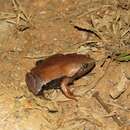en
names in breadcrumbs


The brown egg frog, Ctenophryne geayi, is one of the few South American representatives of the small mouthed frog family (Microhylidae).It is widely distributed east of the Andes in low altitude old growth Amazonian Basin forests (up to 600m asl) in Venezuela, the Guianas, Columbia, Ecuador, Peru, Bolivia and Brazil. As it is nocturnal and lives secretively, burrowing in leaf litter, it is rarely found and not much is known about this species, however its large range and occurrence in multiple protected environments ensure it a least concern rating by the IUCN.The brown egg frog breeds in seasonally flooded pools in slow-draining regions, over the course of about four months during the rainy season. Males call from under the leaf litter, a prolonged trill that possibly shows regionally different pulse rates (Zweifel and Meyers, 1989; La Marca et al. 2010).
Brown egg frogs are uniformly medium brown, with a scattering of little white flecks on their dorsum.They have darker brown sides, legs, and ventral coloring.There is geographical variation of spotting on the underside of the abdomen with southern populations (south of the Amazon River, in north-central Brazil and east-central Peru) having larger spots than the pale and small flecking pattern in northern and western populations (Guiana through Ecuador to central Peru).The chin on males is almost black in color in males, but paler and spotted in females.Back feet are webbed, with males having significantly more webbing than females.Females have a snout-vent length of 42 mm or greater at maturity, a feature distinguishing this species from the only other species in this genus, Ctenophyrne minor, a distinctly smaller species found west of the Andes in the Pacific lowlands of Columbia.The two species were distinguished in 1989 (Zweifel and Myers, 1989).
Ctenophryne geayi (common name: brown egg frog, Spanish: sapito apuntado de Geay) is a species of frog in the family Microhylidae. It is widely distributed in the northern parts of South America, in the Guianas (Guyana, Suriname, French Guiana) and in the Amazon Basin in Venezuela, Colombia, Ecuador, Peru, Bolivia, and Brazil.[1][2][3] It might actually represent two species.[2][4]
Adult males measure 32–43 mm (1.3–1.7 in) and adult females 42–55 mm (1.7–2.2 in) in snout–vent length. The body is rotund, and the head is narrower than the body. The snout is blunt from above and rounded, slightly projecting in profile. The tympanic ring is barely visible externally. The fingers have rounded tips. The toes have flattened tips and webbing that is more extensive in males than in females. Coloration is pale brown dorsally, with darker brown flanks and anterior and posterior surfaces of the thighs. The throat is dark grayish brown, and other ventral surfaces are dark brown with white flecks. A vertebral line might be present. There are two ventral color patterns. Specimens from the northern and western part of the range have pale flecks or very small spots, no more than 1 mm (0.04 in) in diameter but typically less. Southern specimens have larger spots, at least some of them 1.5 mm (0.06 in) or larger, up to a maximum of about 5 mm (0.2 in).[4]
Ctenophryne geayi occurs near flooded depressions and semi-permanent or seasonal ponds of old growth tropical rainforests at elevations up to 600 m (2,000 ft) above sea level. It is a secretive species that is nocturnal and fossorial, found above ground only during brief explosive periods of reproduction in pools. It can locally suffer from habitat loss but is not overall threatened; it occurs in many protected areas.[1]
{{cite journal}}: CS1 maint: multiple names: authors list (link) Ctenophryne geayi (common name: brown egg frog, Spanish: sapito apuntado de Geay) is a species of frog in the family Microhylidae. It is widely distributed in the northern parts of South America, in the Guianas (Guyana, Suriname, French Guiana) and in the Amazon Basin in Venezuela, Colombia, Ecuador, Peru, Bolivia, and Brazil. It might actually represent two species.